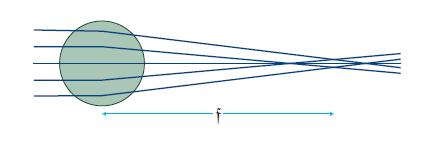Gravitational waves from a distant source travel through the Sun with impunity (negligible absorption and scattering), and
Question:
Gravitational waves from a distant source travel through the Sun with impunity (negligible absorption and scattering), and their rays are gravitationally deflected. The Sun is quite centrally condensed, so most of the deflection is produced by a central region with mass
![]()
and radius Rc ≈ 105 km ≈ R⊙/7, and the maximum deflection angle is therefore △∅ ≈ 4Mc/Rc [Eq. (27.7)]. A few of the deflected rays, along which the waves propagate according to geometric optics, are shown in Fig. 27.4.
(a) Show that the rays are brought to an imperfect focus and thence produce caustics at a distance from the Sun (the focal length) f ∼ Rc2/(4Mc) ∼ 38 AU. A calculation with a more accurate solar model gives f ∼ 20AU, which is near the orbit of Uranus.
(b) If the waves were to have arbitrarily small wavelength λ, then at the caustics, their wave fields h+ and h× would become divergently large. Finite wavelength causes diffraction near the caustics. Explain why the focused field thereby is smeared out over a region with transverse size σ ∼ [λ̅/(2Rc)]f ∼ [λ̅/(8Mc)]Rc.
(c) Explain why, if
![]()
substantial focusing occurs, and the field near the caustics is strongly amplified; but if
![]() there is only slight or no focusing. Explain why it is unlikely that any discrete, strong gravitational-wave sources in the universe emit wavelengths shorter than 3M⊙ ∼ 5 km and therefore are strongly lensed by the Sun.
there is only slight or no focusing. Explain why it is unlikely that any discrete, strong gravitational-wave sources in the universe emit wavelengths shorter than 3M⊙ ∼ 5 km and therefore are strongly lensed by the Sun.
Equation 27.7.
![]()
Figure 27.4.

Step by Step Answer:

Modern Classical Physics Optics Fluids Plasmas Elasticity Relativity And Statistical Physics
ISBN: 9780691159027
1st Edition
Authors: Kip S. Thorne, Roger D. Blandford





